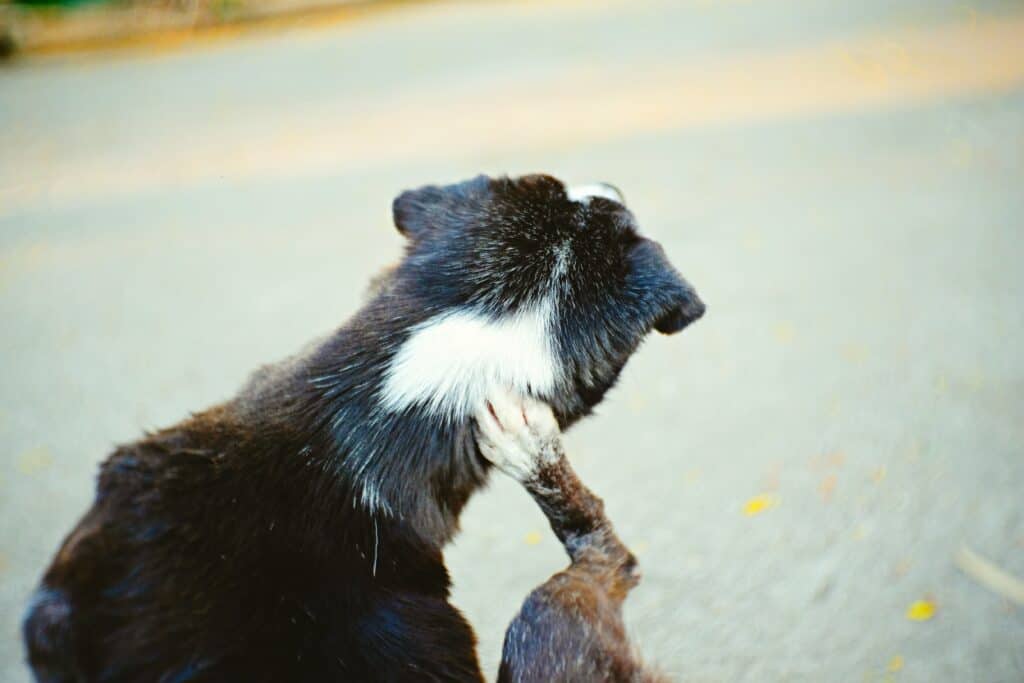Types Of Dog Brushes
Grooming your dog regularly helps minimize shedding, control where that loose hair falls, and improve the health of your dog’s

We’re talking about fleas, the tiny insects that love to hop onto other animals and wreak havoc. They’re usually smaller than a grain of rice and can be easily contracted just by sending your dog outside. Cats and humans can also become hosts to fleas, so if you think there are some in your home, it’s best to take action immediately. But how can you tell if your dog has fleas? And what should you do to get rid of fleas on dogs?
Table of Contents
Luckily, there are many ways to detect if your dog (or your home) has fleas. Observe how your dog has been behaving and take note of any changes or abnormalities. There are also several things you can look for throughout your house that can indicate the presence of these small, unintended roommates. If you think your dog might have fleas, take a look at these top symptoms of fleas on dogs:
Dogs might scratch or bite themselves for different reasons. Sometimes, they’re just a little itchy. Sometimes, they’re looking for stimulation. But sometimes, scratching and biting can be an indication of a bigger issue. If your dog has fleas, it will scratch itself frequently and frantically. They will also try to chew on their skin in order to find some temporary relief.
If you notice your dog scratching and chewing on their skin more than usual, grab a comb and a flashlight, and move on to #2.
You might be asking yourself what ‘flea dirt’ is. We’re sorry to say that it’s not dirt at all: it’s flea poop. These little buggers can make a big mess in your dog’s fur, as well as your dog’s bedding, your furniture and carpets, and any other small warm area that they can hide in. If you’ve got fleas, you’ll find flea poop. And to make matters even grosser, flea feces are made of digested blood. Double yuck.
Use a fine-toothed comb to look through your dog’s fur. Flea dirt looks like small dark specks, similar to pepper or dirt, so it can be difficult to tell if what you’re looking at is actually flea feces or not. If you think you’ve found flea dirt on your dog or in your home, try gathering some of it on a paper towel and dripping a small amount of water on it. If the specks turn red, you’ve found flea dirt.
If you’re still not sure if your dog has fleas, use your comb to look for the fleas themselves. Fleas are usually a reddish brown color, and despite being so small, they can be visible to the naked eye.
The difficulty with finding fleas is that their eggs and their babies (aka larva and pupa) are very small. It’s easy to miss them, especially if your dog has lots of long hair. Adult fleas are easier to spot due to their size, as well as their movements—an adult flea can jump up to 100 times its length!
Whether or not your dog grooms themselves often, chances are they will groom themselves more if they have fleas. This increase can be dramatic, to the point that they accidentally remove some of their own furs and injure themselves!
Additionally, dogs with extra sensitive skin can develop ‘hot spots,’ or red, inflamed skin, where they have been bitten by fleas. If they continue to over-groom and scratch these areas, they can develop serious health issues, such as flea allergy dermatitis.
In short, pay attention to how much your dog is grooming itself, and look for any signs of skin irritation or injury. These areas can most often be found near the neck, flanks, or base of the tail. Be sure to contact your veterinarian if you find wounds or sores on your dog.
If you’re really lucky, your dog may actually notice fleas before catching them. Fleas like to live in warm places where they can easily hide, such as the spaces between floorboards or tile, or within carpet or furniture. If your dog begins avoiding an area of your home or yard, use a flashlight to thoroughly investigate the area for fleas or other potential pests.
A personality shift can be an indicator of all kinds of problems with a dog’s health, including fleas. A dog with fleas can be very agitated and restless, and they can even become more aggressive. If your dog begins acting in a way that’s out-of-character, consider checking for fleas, or even contacting your vet right away.
In extreme cases, fleas can consume so much blood that they cause anemia in their host. Puppies and elderly dogs are the most likely to become anemic due to flea infestation, as are dogs who are already sick. Signs of anemia in dogs include weight loss, pale gums, lethargy or exhaustion, and muscle loss. If you suspect that your dog is suffering from anemia—from fleas or otherwise—contact your veterinarian immediately.
Finally, be on the lookout for tapeworms in your dog’s bedding, feces, or around their anus. While dogs can contract tapeworms from any infected insect, fleas are the most common host. These tiny rice-like pests are incredibly dangerous for dogs, and they love to infect fleas. They also eat flea dirt—if you find tapeworms on your dog, you’ll almost certainly find fleas. Contact your veterinarian immediately if you think your dog has tapeworms.
At this point, you’re probably wondering how to get rid of fleas on dogs. Are their home remedies for fleas on dogs? What kills fleas on dogs instantly?
Despite their small size, fleas can cause BIG issues for dogs and their owners. If your dog has fleas, contact your vet right away. They will be able to walk you through the necessary steps for helping your dog—and your home—to get rid of fleas.
There are some tried-and-true products and methods you can use to help remove fleas from your dog while you wait for their vet appointment:
Be sure to ask your veterinarian for product recommendations to help rid your dog of fleas.
 Ashley
Ashley
Grooming your dog regularly helps minimize shedding, control where that loose hair falls, and improve the health of your dog’s
Have you begun to notice a little more cat fur around the home than you are used to? Most cat
A slicker brush is one of the most essential tools in your dog grooming arsenal. This product can do it
TO GET 15% OFF ON ALL YOUR PURCHASES